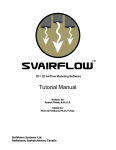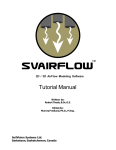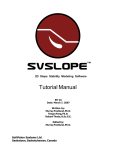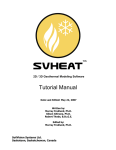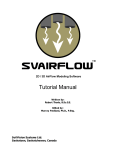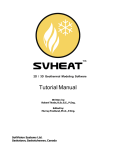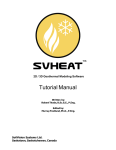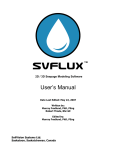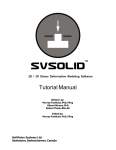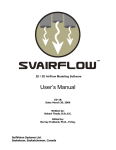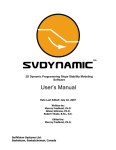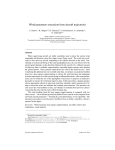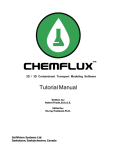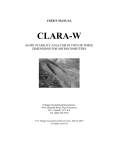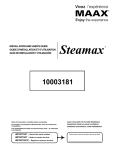Download SVAirFlow Tutorial Manual
Transcript
2D / 3D AirFlow Modeling Software Tutorial Manual Date Last Edited: May 22, 2007 Written by: Robert Thode, B.Sc.G.E. Edited by: Murray Fredlund, Ph.D., P.Eng. SoilVision Systems Ltd. Saskatoon, Saskatchewan, Canada Software License The software described in this manual is furnished under a license agreement. The software may be used or copied only in accordance with the terms of the agreement. Software Support Support for the software is furnished under the terms of a support agreement. Copyright Information contained within this User’s Manual is copyrighted and all rights are reserved by SoilVision Systems Ltd. The SVAIRFLOW software is a proprietary product and trade secret of SoilVision Systems. The User’s Manual may be reproduced or copied in whole or in part by the software licensee for use with running the software. The User’s Manual may not be reproduced or copied in any form or by any means for the purpose of selling the copies. Disclaimer of Warranty SoilVision Systems Ltd. reserves the right to make periodic modifications of this product without obligation to notify any person of such revision. SoilVision does not guarantee, warrant, or make any representation regarding the use of, or the results of, the programs in terms of correctness, accuracy, reliability, currentness, or otherwise; the user is expected to make the final evaluation in the context of his (her) own problems. Trademarks Windows™ is a registered trademark of Microsoft Corporation. SoilVision® is a registered trademark of SoilVision Systems Ltd. SVFLUX ™ is a trademark of SoilVision Systems Ltd. CHEMFLUX ™ is a trademark of SoilVision Systems Ltd. SVSOLID ™ is a trademark of SoilVision Systems Ltd. SVHEAT ™ is a trademark of SoilVision Systems Ltd. ACUMESH ™ is a trademark of SoilVision Systems Ltd. FlexPDE® is a registered trademark of PDE Solutions Inc. Surfer® is a registered trademark of Golden Software Inc. Slicer Dicer® is a registered trademark of Visualogic Inc. Copyright © 2007 by SoilVision Systems Ltd. Saskatoon, Saskatchewan, Canada ALL RIGHTS RESERVED Printed in Canada Table of Contents 1 A 1.1 1.2 1.3 1.4 3 of Two Dimensional Example Model ................................................................................................................................... Adding a Project ................................................................................................................................... Adding a Model ................................................................................................................................... Opening the Model ................................................................................................................................... Defining the Model 1.4.1 ................................................................................................................................... Setting the World Coordinate System 1.4.2 ................................................................................................................................... Define Material Properties 1.4.3 ................................................................................................................................... Adding Regions 1.4.4 ................................................................................................................................... Defining Region Geometry Shapes 1.4.5................................................................................................................................... Specifying Initial Conditions 1.4.6................................................................................................................................... Specify Boundary Conditions ................................................................................................................................... 1.5 Reporting 1.5.1................................................................................................................................... Specifying a Boundary Flux 1.5.2................................................................................................................................... Specify Plots 1.5.3................................................................................................................................... Specify Output Files ................................................................................................................................... 1.6 Analyze ................................................................................................................................... 1.7 Results 2 2D Stochastic Example ................................................................................................................................... 2.1 Create a new model 2.2 Set................................................................................................................................... stages ................................................................................................................................... 2.3 Modify soil properties ................................................................................................................................... 2.4 Model solution 3 A Three Dimensional Example Model ................................................................................................................................... 3.1 Adding a Project ................................................................................................................................... 3.2 Adding a Model ................................................................................................................................... 3.3 Opening the Model ................................................................................................................................... 3.4 Defining the Model 3.4.1................................................................................................................................... Specify Settings 3.4.2................................................................................................................................... Setting the Workspace 3.4.3................................................................................................................................... Define Material Properties 3.4.4................................................................................................................................... Define 3D Surfaces 3.4.5................................................................................................................................... Adding Regions 3.4.6................................................................................................................................... Defining Region Geometry Shapes 26 5 5 6 6 7 7 8 9 9 10 10 11 11 12 12 13 13 14 14 14 14 15 16 16 17 17 17 17 18 18 19 19 20 Table of Contents 4 ................................................................................................................................... 3.4.8................................................................................................................................... Specify Boundary Conditions ................................................................................................................................... 3.5 Specify Plots ................................................................................................................................... 3.6 Specify Output Files ................................................................................................................................... 3.7 Analyze ................................................................................................................................... 3.8 Results 3.8.1................................................................................................................................... AcuMesh 4 References 3.4.7 Specifying a Soil by Region and Layer of 26 21 21 22 22 23 23 23 25 A Two Dimensional Example Model 1 5 of 26 A Two Dimensional Example Model The following example will introduce some of the features included in SVAIRFLOW and will set up a model of a simple air injection well. The purpose of this model is to determine the effects of a clay layer on the air pressure contours around an injection well. The well dimensions have been exaggerated for simplicity and viewing purposes. The model dimensions and soil properties are provided below. Project Name: Tutorial Model Name: SingleWellwClay Minimum authorization required: STUDENT · Model Diagram · Soil Properties Sand: air conductivity, ka = 2.18E-04 m/s Clay: air conductivity, ka = 2.18E-05 m/s 1.1 Adding a Project The first step in defining a model is to decide the project under which the model is going to be organized. If the project is not yet included, you must add the project before proceeding with the model. In this case, the model is placed under a project called Tutorial. In order to add the Tutorial project, follow these steps: 1. Access the SVOffice 2006 Manager dialog. A Two Dimensional Example Model 6 of 26 2. Click New in the upper right of the Projects section. 3. The Create New Project dialog is opened along with a prompt asking for a new Project Name. 4. Type “Tutorial” as the new Project Name and press OK. The Project Properties dialog is where information specific to each project is stored. This includes the Project Name, Location, Start Date, End Date, Project Notes, client information, contractor and project engineer information. The Project Name is the only required information needed to define a project. The rest of the fields are optional. The dialog is opened ready to accept information. It should be noted that once the project is defined it is identified by the Project Name throughout the rest of the program. Also, SVAIRFLOW does not allow you to specify two projects with the same Project Name. 5. Fill out the Project Properties dialog with the desired information. 6. To exit this dialog and return to SVOffice 2006 Manager, click OK. The project information is automatically saved upon entry. Adding a Model 1.2 The first step in adding a model is to decide the project under which the model is going to be placed. If the project is not yet included, you must add the project before proceeding with the model, as detailed in the previous section. When the SVOffice 2006 Manager dialog is opened, there will be a list of the projects that have been defined. In this case there is only the Tutorial project. To add a model: 1. 2. 3. 4. 5. 6. 7. Select the Tutorial from the Projects list. Press the "New..." button under the 'Models' heading. Enter the Model Name 'SingleWellwClay' in the model name box. Select SVAirflow from the Application drop-down. Select 2D for System, Steady-State for Type, Metric for Units, and Seconds for Time Units. Click the OK button to save the model and close the New Model dialog. The new model will automatically open in the workspace. Opening the Model 1.3 If the model was just added it will already be open in the workspace. When returning to the model, follow these steps to open it in the workspace: 1. 2. 3. 4. Select the Tutorial Project in the SVOffice Manager dialog. Ensure that SVAirflow is selected from the Application drop-down. Select SingleWellwClay from the Models list. The model may opened by clicking the Open button or by double clicking on the model name. A Two Dimensional Example Model 7 of Defining the Model 1.4 The following section provides instructions on how to begin defining the model in the workspace. Setting the World Coordinate System 1.4.1 Before entering any model geometry it is best to set the World Coordinate System to ensure that the model will fit in the drawing space. 1. Access the World Coordinates System dialog by selecting View > World Coordinates System. 2. Enter the World Coordinates System coordinates shown below for the X and Y axes. 3. 4. 5. 6. Click OK to close the dialog. Select Format > Axis from the menu. Move to the Scale tab. Enter the values shown below for both the X and Y axis. 26 A Two Dimensional Example Model 8 of 26 7. Click OK to close the dialog. The workspace grid spacing needs to be set to aid in defining region shapes. The SandySoil region of the model has coordinates of a precision of 0.5m. In order to effectively draw geometry with this precision using the mouse, the grid spacing must be set to a maximum of 0.5. 1. Select View > Options from the menu. 2. Enter 0.5 for both the horizontal and vertical spacing. 3. Click OK to close the dialog. Define Material Properties 1.4.2 The next step in defining the model is to enter the material properties for the two soils that will be used in the model. A sand is defined for the majority of the model and a clay layer extends horizontally through the middle. This section will provide instructions on creating the sand soil. Repeat the process to add the clay soil. 1. 2. 3. 4. Open the Soils dialog by selecting Model > Soils > Manager from the menu. Click the New... button to create a soil. Enter Sand for the soil name in the dialog which appears. Press OK to close the dialog. The Soil Properties dialog will open automatically. When a new soil is created, you can specify the display color of the soil using the Fill Color box on the Soil Properties menu. Any region that has a soil assigned to it will display that soil's fill color. 5. Move to the Conductivity tab and select Constant/Expression from the drop-down. 6. Enter the ka value of 2.18E-04 m/s. 7. Click OK to close the Soil Properties dialog. A Two Dimensional Example Model 9 of 26 8. Repeat these steps to create the clay soil; refer to the data provided in the "A Two Dimensional Example Model" section at the beginning of this tutorial. 9. Press OK to close the Soils Manager dialog. 1.4.3 Adding Regions This model will be divided into two regions, which are named SandySoil and ClayLayer. Each region will have one of the soils just defined specified as its soil properties. To add the necessary regions follow these steps: 1. Open the regions dialog by selecting Model > Geometry > Regions from the menu. 2. Change the first region name from R1 to SandySoil. To do this, highlight the name and type new text. 3. Select the Sand from the Soil drop-down. 4. Press the New button to add a second region. 5. Change the name of the second region to ClayLayer. 6. Select the Clay soil for the ClayLayer region. 7. Check the Show checkboxes. This will display graphical representations for the boundary conditions when they are defined later in this tutorial. 8. Click OK to close the dialog. 1.4.4 Defining Region Geometry Shapes The shapes that define each soil region will now be created. Note that when drawing geometry shapes, the region that is current in the region selector is the region the geometry will be added to. The Region Selector is at the top of the workspace. SandySoil ClayLayer · Define the SandySoil 1. Ensure the “SandySoil” region is current in the region selector drop-down. 2. Select Draw > Model Geometry > Region Polygon from the menu. 3. Move the cursor near (0,0) in the drawing space. You can view the coordinates of the current position the mouse is at in the status bar just below the drawing space. 4. To select the point as part of the shape left click on the point. 5. Now move the cursor near (50,0). Left click on the point and a line is now drawn from (0,0) to (50,0). 6. Move the cursor near the point (50,50). Left click on the point and a line is now drawn from (50,0) to (50,50). 7. Move the cursor near the point (27.5,50) Left click on the point and a line is now drawn from (50,50) to (27.5,50). 8. Repeat to draw the next 5 segments. 9. For the last point, move the cursor near the point (0,50) and double click on the point to finish the A Two Dimensional Example Model 10 of 26 shape. A line is now drawn from (22.5,50) to (0,50) and the shape is automatically finished by SVAIRFLOW by drawing a line from (0,50) back to the start point, (0,0). If the SandySoil geometry been entered correctly the shape should look like the model diagram at the beginning of this tutorial. If a mistake was made entering the coordinate points for a shape, edit the shape using the Region Properties dialog (menu item Model > Geometry > Region Properties). · Define the ClayLayer 1. Ensure that “ClayLayer” is current in the region selector. 2. Select Draw > Model Geometry > Region Polygon from the menu. 3. Move the cursor near (0,28) in the drawing space. You can view the coordinates of the current position the mouse is at in the status bar just below the drawing space. 4. To select the point as part of the shape left click on the point. 5. Now move the cursor near (50,28) and left click on the point. A line is now drawn from (0,28) to (50,28). 6. Repeat the process for the point (50,26). 7. For the final point, move the cursor near the point (0,26) and double click on the point to finish the shape. A line is now drawn from (50,26) to (0,26) and the shape is automatically finished by SVAIRFLOW by drawing a line from (0,26) back to the start point, (0,0). At times it may be tricky to snap to a grid point that is near a line defined for a region. Turn the object snap off by clicking on “OSNAP” in the status bar to alleviate this problem. Specifying Initial Conditions 1.4.5 To open the Settings dialog select Model > Initial Conditions > Settings in the workspace menu. The Settings dialog contains information about the current model System, Type, Units, and Initial Conditions. The air conductivity data for the soils contained in the model are reported as m/s so the time units will remain s, for seconds. A temperature of 15oC is required. 1. 2. 3. 4. 5. 1.4.6 Select Model > Initial Conditions > Settings from the menu. Move to the Temperature tab. Select the Constant/Expression Temperature Option. Enter a temperature value of 15. Click OK to close the Initial Conditions dialog. Specify Boundary Conditions Boundary conditions must be applied to region points. Once a boundary condition is applied to a boundary point the starting point is defined for that particular boundary condition. The boundary condition will then extend over subsequent line segments around the edge of the region in the direction in which the region shape was originally entered. Boundary conditions remain in effect around a shape until re-defined. The user cannot define two different boundary conditions over the same line segment. More information on boundary conditions can be found in Menu System > Model Menu > Boundary Conditions > 2D Boundary Conditions in your User's Manual. Now that all of the regions and the model geometry have been successfully defined, the next step is to specify the boundary conditions. An atmospheric pressure of 101.2 kPa is applied at the ground surface and a pressure of 101.3 kPa is applied at the base of the model to provide a small gradient. The injection well A Two Dimensional Example Model 11 of 26 pressure is 102 kPa. The steps for specifying the boundary conditions are thus: · SandySoil 1. Select the “SandySoil” region in the drawing space. 2. From the menu select Model > Boundaries > Boundary Conditions. The boundary conditions dialog will open. By default the first boundary segment will be given a Zero Flux condition. 3. Select Pressure Expression from the Boundary Condition drop-down. 4. Enter 101.3 in the Expression field. 5. Select the point (50,0) from the list. 6. Select the Zero Flux condition from the drop-down. 7. Apply the remaining boundary conditions referring to the list above. 8. Click the OK button to close the dialog. The Pressure Expression boundary condition for the point (27.5,50) becomes the boundary condition for the following line segments that have a Continue boundary condition until a new boundary condition is specified. In this case the line segments from (27.5,50) to (22.5,35) are all given a zero flux boundary condition. · ClayLayer By default a Zero Flux boundary condition is set for the ClayLayer region and this condition is appropriate so no specifications are required. 1.5 Reporting Now that the model is defined, it is necessary to specify the reports which will be created by the solver such that the desired output from the model can be seen. 1.5.1 Specifying a Boundary Flux Boundary Flux specifications are used to report the rate of flow across a boundary for a steady state analysis and the rate and volume of flow moving across a boundary in a transient analysis. Boundary Names must be assigned using the Region Properties dialog and then Reports selected using the Boundary Flux dialog. 1. Click on the SandySoil region shape in the workspace with the mouse. 2. Select Model > Boundaries > Boundary Conditions from the menu to open the Boundary Conditions dialog. By default the point (0,0) has a Boundary Name defined. 3. Select the point (27.5,35). 4. Enter the boundary name WellScreen. 5. Select point (22.5,35) from the list. A Two Dimensional Example Model 12 of 26 6. 7. 8. 9. 10. Enter End as the boundary name. Press OK to close the dialog. Select Model > Reporting > Plot Manager from the menu to open the Plot Manager dialog. Select the Boundary Flux tab and select WellScreen from the list. Press the Properties button to open the Plot Properties Boundary Flux dialog and select the Output Options tab. 11. Click the checkbox beside PLOT. 12. Click OK to close the dialog. 13. Click OK to close the Plot Manager dialog and return to the workspace. 1.5.2 Specify Plots There are many plot types that can be specified to visualize the results of the model. A few will be generated for this tutorial example model including a plot of the solution mesh, air pressure contours, and gradient vectors. 1. Open the Plot Manager dialog by selecting Model > Reporting > Plot Manager from the menu. 2. The toolbar at the bottom left of the dialog contains a button for each plot type. Click on the Contour button to begin adding the first contour plot. The Plot Properties dialog open. 3. Enter the title Air Pressure. 4. Select ua as the variable to plot from the drop-down. 5. Select the PLOT output option. 6. Click OK to close the dialog and add the plot to the list. 7. Repeat these steps 2 – 6 to create the plots shown above. 8. Click OK to close the Plot Manager and return to the workspace. 1.5.3 Specify Output Files There are four output file types that can be specified to export the results of the model. Two will be generated for this tutorial example model: a transfer file of air pressure, and a file to transfer the results to AcuMesh. Note that the file uaTransfer.trn is already present. It is generated by default for every model. 1. Open the Output Manager dialog by selecting Model > Reporting > Output Manager from the menu. 2. The toolbar at the bottom left of the dialog contains a button for each output file type. Click on the A Two Dimensional Example Model 3. 4. 5. 6. 7. 8. 1.6 13 of 26 AcuMesh button to begin adding the output file. The Output File Properties dialog will open. Enter the title uaAcuMesh. Select the variable ua in the variable list. Press the Add Selection button. Check the Write File box under the Output Options tab. Click OK to close the dialog and add the output file to the list. Click OK to close the Output Manager and return to the workspace. Analyze The next step is to analyze the model. Click the Analyze button located on the left of the workspace. This action will write the descriptor file and open the SVAIRFLOW solver. The solver will automatically begin solving the model. 1.7 Results After the model has finished solving, the results will be displayed in the dialog of thumbnail plots within the SVAIRFLOW solver. Right-click the mouse and select Maximize to enlarge any of the thumbnail plots. The five plots that were generated for this tutorial are: the Model Properties report providing details on the model, a contour plot of air pressures indicating pressurization around the well bore and the change in pressure gradients in the clay layer, a plot of airflow gradients indicating direction and magnitude of flow, a plot of the solution mesh generated by the solver, and a boundary flux report stating a normal flow of 0.020601 m3/s through the well screen. 2D Stochastic Example 2 14 of 26 2D Stochastic Example A single run of a numerical model is often not sufficient. SVAIRFLOW implements the ability to incorporate statistical uncertainty into the input of soil properties. This tutorial section guides the user through the setup and execution of a model implementing the stochastic or statistical features available in SVAIRFLOW. The air injection well example presented in Section 1 is extended to incorporate a variation in the air conductivity, ka of the clay layer. Instead of specifying a single value for this parameter an incremental analysis will be used to generate 50 runs of the same model varying the “ka” parameter over 6 orders of magnitude. Why do we want to do this? In this example we want to determine the influence of the ka on the difference in pressure distributions around the injection well. The sensitivity of the ka value may be significant in determining injection rates. The final model is presented in the models files under the Tutorial project, named SingleWellwClaySto. Create a new model 2.1 The first step in creating the stochastic model is to save a copy of the example model created in section 1. This is accomplished through the following steps: 1. Open the Tutorial > SingleWellwClay model, 2. Select File > Save Model As… 3. Type the name “SingleWellwClaySto” and click OK. Now a new model has been created and loaded into the workspace that will be modified to include stochastic analysis. Set stages 2.2 The second step is to describe the number of stages/runs that will be used in the analysis. Stages are controlled in SVAIRFLOW by opening the Model > FEM Options dialog. The STAGES field should be set to 50 under the Stage Controls area of the dialog. Click Yes for the warning message and then close the FEM Options dialog. Modify soil properties 2.3 The next step that must occur is that the ka value will be staged. In this example the parameter will be set to have a mean value of 5 and a standard deviation of 2. This staging is accomplished through the following process: 1. 2. 3. 4. 5. 6. 7. 8. 9. Select Model > Soils > Manager… to open the list of current soils, Select the “ClayLayer” soil and click the “Properties…” button, Click the “Stage Parameters…” button located in the lower left of the dialog, Select the “ka” parameter and click the “Include” button, Click the “Stage Values…” button, Click the “Increment Stage Values…” button, Enter a start of 0.0000001 and an increment of 0.001 and click the OK button, A list of 50 generated values will now be displayed in the Stage Values list box. Press OK on all remaining dialogs to close them. The parameter has now been staged. 2D Stochastic Example 2.4 15 of 26 Model solution Selecting Solve > Analyze from the menu will initiate model solution. Attention should be directed to the stage display in the finite element solver. Once a particular stage is complete the next stage will automatically be initiated. The differential flows through the sandy soil and clay layer may be seen in the gradient plot as the air conductivity in the clay layer varies. A Three Dimensional Example Model 3 16 of 26 A Three Dimensional Example Model The following example will introduce you to the three dimensional SVAIRFLOW modeling environment. This example is used to investigate the flow of contaminated air into a basement. A 1 cm crack exists between the floor slab and the basement walls. Project Name: Tutorial Model Name: Floor Leak Minimum authorization required: FULL 3.1 Adding a Project The first step in defining a model is to decide the project under which the model is going to be organized. If the project is not yet included you must add the project before proceeding with the model. In this case, the model is placed under a project called Tutorial. In order to add this project, follow these steps: 1. Access the SVOffice 2006 Manager dialog. If a project named Tutorial already exists skip to section the Adding a Model section. 2. Click New in the upper right of the Projects section. 3. The Create New Project dialog is opened along with a prompt asking for a new Project Name. 4. Type “Tutorial” as the new Project Name and press OK. The Project Properties dialog is where your information specific to each project is stored. This will include the Project Name, Location, Start Date, End Date, Project Notes, client information, contractor and project engineer information. A Three Dimensional Example Model 17 of 26 The Project Name is the only required information needed to define a project. The rest of the fields are optional. It should be noted that once the project is defined it would be identified by the Project Name throughout the rest of the program. Also, SVAIRFLOW does not allow you to specify two projects with the same Project Name. 5. Fill out the Project Properties dialog with the desired information. 6. To exit this dialog and return to the SVOffice 2006 Manager, click OK. The project information is automatically saved upon entry. Adding a Model 3.2 Once a project has been created any number of models may be stored in it. When the Projects/Models dialog is opened there will be a list of the projects that have been defined. To add a model to the Tutorial project follow these steps: 1. 2. 3. 4. 5. Press the "New..." button under the 'Models' heading. Enter Floorleak in the Model Name box. Select 3D for System, Steady-State for Type, Metric for Units, and Seconds for Time Units. Click the OK button to save the model and close the New Model dialog. The new model will automatically be opened in the workspace. Opening the Model 3.3 If the model was just added it will already be open in the workspace. When returning to the model, follow these steps to open it in the workspace: 1. Select the Tutorial Project in the SVOffice 2006 Manager dialog. 2. Select FloorLeak under the Models list.. 3. The model may opened by clicking the Open button or by double clicking on the model name. Defining the Model 3.4 The following section provides instructions on how to begin defining the model in the workspace. Specify Settings 3.4.1 The first step in defining the model is to specify the settings that will be used for the model. To open the Settings dialog select Model > Settings in the workspace menu. The Settings dialog will contain information about the current model System, Type, Units, and Transient Settings. The air conductivity data for the soil contained in the model is reported as m/s so the time units will remain s, for seconds. A temperature of 15oC is required. 1. 2. 3. 4. 5. Select Model > Initial Conditions > Settings from the menu. Move to the Temperature tab. Select the Constant/Expression Temperature Option. Enter a temperature value of 20. Click OK to close the Settings dialog. A Three Dimensional Example Model 3.4.2 18 of 26 Setting the Workspace Before entering any model geometry it is best to set the Format Axis settings to ensure that the model will fit in the drawing space. 1. Select Format > Axis from the menu. Enter the values shown below for both the X and Y axis. 2. Click OK to close the dialog. 3.4.3 Define Material Properties The next step in defining the model is to enter the material property for the soil that will be used in the model. It will be defined for all the regions. 1. Open the Soils Manager dialog by selecting Model > Soils > Manager… from the menu. 2. Click the New... button to create a soil. Enter Soil1 for the name. 3. The Soil Properties dialog will open automatically; or, select the new soil and click Properties to open the Soil Properties dialog. 4. Move to the Conductivity tab. 5. Enter the ka expression of 7E-08*(z/5.5) m/s. This expression will cause the air conductivity to vary with depth, z. 6. Press OK on the Soils Manager dialog to close both dialogs. A Three Dimensional Example Model 19 of 26 Define 3D Surfaces 3.4.4 This model consists of three surfaces defined by constant elevations. By default every model initially has two surfaces. · Define Surface 1 This surface will be defined by providing a constant elevation. 1. 2. 3. 4. 5. Select Surface 1 in the Surface Selector located at the top of the workspace. Select Model > Geometry > Surface Properties in the menu to open the Surface Properties dialog. For the Surface Definition option, select Expression (Relative) Enter a Surface Expression of 0. Click OK to close the dialog. · Define Surface 2 This surface will be defined by providing a constant elevation. 1. 2. 3. 4. 5. Select Surface 2 in the Surface Selector located at the top of the workspace. Select Model > Geometry > Surface Properties in the menu to open the Surface Properties dialog. For the Surface Definition option, select Expression (Relative) Enter a Surface Expression of 4. Click OK to close the dialog. · Insert and Define Surface 3 Surface 3 is not present by default and must be created using the Insert Surface dialog. 1. Open the Surfaces dialog by selecting Model > Geometry > Surfaces from the menu. Press the New button to add surfaces. 2. 1 is selected in the Number of New Surfaces dialog and Place New Surfaces At The Top is the default selected, so press OK to add Surface 3 and close the dialog. 3. Click OK to close the Surfaces dialog. 4. Select Surface 3 in the Surface Selector located at the top of the workspace. 5. Select Model > Geometry > Surface Properties from the menu. 6. For the Surface Definition option, select Expression (Relative) 7. Enter a Surface Expression of 5.5. 8. Click OK to close the dialog. Adding Regions 3.4.5 A region in SVAIRFLOW is the basic building block for a model. A region represents both a physical portion of soil being modeled and a visualization area in the SVAIRFLOW CAD workspace. A region will have a set of geometric shapes that define its soil boundaries. Also, other modeling objects including features, flux sections, text, and line art can be defined on any given region. This model will be defined by three regions, which are named Outer, BasementIn, and Crack. To add the necessary regions follow these steps: 1. 2. 3. 4. 5. 6. 7. Open the regions dialog by selecting Model > Geometry > Regions from the menu. Change the first region name from R1 to Outer. To do this, highlight the name and type new text. Press the New button to add a second region. Change the name of the second region to BasementIn. Press the New button to add a third region. Change the name of the third region to Crack. Click OK to close the dialog. A Three Dimensional Example Model 3.4.6 20 of 26 Defining Region Geometry Shapes The shapes that define each region will now be created. Note that when drawing geometry shapes the region that is current in the region selector is the region the geometry will be added to. The Region Selector is at the top of the workspace. Outer BasementIn Crack · Define the Outer region 1. Ensure the “Outer” region is current in the region selector. 2. Select Draw > Model Geometry > Polygon Region from the menu. 3. Move the cursor near (50,50) in the drawing space. You can view the coordinates of the current position the mouse is at in the status bar just above the command line. 4. When the cursor is near the point, click the left mouse button. The cursor should automatically snap to the point (50,50) as long as the cursor is close to the point and the SNAP and GRID options in the status bar are both bold. 5. Now move the cursor near (70,50). Left click on the point. A line is now drawn from (50,50) to (70,50). 6. Now move the cursor near (70,70). Left click on the point. A line is now drawn from (70,50) to (70,70). 7. For the last point (50,70), double click on the point to finish the shape. A line is now drawn from (70,70) to (50,70) and the shape is automatically finished by SVAIRFLOW by drawing a line from (50,70) back to the start point, (50,50). Select a shape with the mouse and select Edit > Delete from the menu if a mistake was made entering the coordinate points for a shape. This will remove the entire shape from the region. To edit the shape use the Region Properties dialog. · Define the BasementIn In the instructions for defining the Outer shape the command line was used. To draw the BasementIn region the instructions below explain the use of the drawing tool to create the BasementIn shape. 1. Ensure that “BasementIn” is current in the region selector. 2. Select Draw > Model Geometry > Polygon Region from the menu. 3. Move the cursor near (50,50) in the drawing space. You can view the coordinates of the current position the mouse is at in the status bar just above the command line. 4. When the cursor is near the point, click the left mouse button. The cursor should automatically snap to the point (50,50) as long as the cursor is close to the point and the SNAP and GRID options in the status bar are both bold. 5. Now move the cursor near (59.8,50). Left click on the point. A line is now drawn from (50,50) to (59.8,50). 6. Repeat this process for the next point. If a mistake is made simply press the delete key on the keyboard and start over. 7. For the last point (50,59.8), double click on the point to finish the shape. A line is now drawn from (59.8,59.8) to (50,59.8) and the shape is automatically finished by SVAIRFLOW by drawing a line from (50,59.8) back to the start point, (50,50). A Three Dimensional Example Model 21 of 26 At times it may be tricky to snap to a grid point that is near a line defined for a region. Turn the object snap off by clicking on “OSNAP” in the status bar to alleviate this problem. · Define the Crack Follow the above method to define the Crack shape, referring to the table of points above. After all the region geometry has been entered it will appear like the diagram at the beginning of this tutorial. Specifying a Soil by Region and Layer 3.4.7 Each region will cut through all the layers in a model creating a separate “block” on each layer. Each block can be assigned a soil or be left as void. A void area is essentially air space. In this model all “blocks” will be assigned a soil. 1. 2. 3. 4. 5. 6. 7. 8. 9. 10. 11. 3.4.8 Select “Outer” in the Region Selector. Select Model > Soils > Region Soils from the menu to open the Region Soils dialog. Select the Soil1 soil from the drop-down for Layer 1. Select the Soil1 soil from the drop-down for Layer 2. Select “BasementIn” in the Region Selector. Select Model > Soils > Region Soils from the menu to open the Region Soils dialog. Select the Soil1 soil from the drop-down for Layer 1. Select “Crack” in the Region Selector. Select Model > Soils > Region Soils from the menu to open the Region Soils dialog. Select the Soil1 soil from the drop-down for Layer 1. Close the dialog using the OK button. Specify Boundary Conditions Boundary conditions must be applied to region points. Once a boundary condition is applied to a boundary point this defines the starting point for that particular boundary condition. The boundary condition will then extend over subsequent line segments around the edge of the region in the direction in which the region shape was originally entered. Boundary conditions remain in effect around a shape until re-defined. The user may not define two different boundary conditions over the same line segment. More information on boundary conditions can be found in Menu System > Model Menu > Boundary Conditions > 2D Boundary Conditions in your User's Manual. Now that all of the regions, surfaces, and the soils have been successfully defined, the next step is to specify the boundary conditions on the region shapes. The ground surface will be set at a pressure of 101.3 kPa while the basement will be set at a pressure of 101.2 kPa. The steps for specifying the boundary conditions include: 1. Select the “Outer” region in the drawing space. 2. Select Surface 3 in the surface selector. 3. From the menu select Model > Boundaries > Boundary Conditions. The boundary conditions dialog will open and display the boundary conditions for Surface 3. 4. Move to the Surface Boundary Conditions tab. 5. From the Boundary Condition drop down select a Pressure Expression boundary condition. This will cause the Expression box to be enabled. 6. In the Expression box enter a pressure of 101.3. 7. Click the OK button to save the boundary condition to the list. Now, to set the Crack regions Surface 2 Boundary Condition to 101.2: A Three Dimensional Example Model 22 of 26 1. 2. 3. 4. 5. Select the “Crack” region in the drawing space. Select Surface 2 from the surface drop-down. From the menu select Model > Boundaries > Boundary Conditions. Click the Surface Boundary Conditions tab. Select the Pressure Expression boundary condition and enter a value of 101.2 in the expression box. 6. Close the dialog using the OK button. The remaining Surfaces are by default set to the None boundary condition, which is treated as a Zero Flux condition. The remaining Segments are by default set to the No BC boundary condition, which also is treated as a Zero Flux condition. 3.5 Specify Plots There are many plot types that can be specified to visualize the results of the model. A few will be generated for this tutorial example model including a plot of the pressure contours, solution mesh, and gradient vectors. 1. Open the Plot Manager dialog by selecting Model > Reporting > Plot Manager from the menu. 2. The toolbar at the bottom left of the dialog contains a button for each plot type. Click on the Contour button to begin adding the first contour plot. The Plot Properties dialog will open. 3. Enter the title air pressure. 4. Select ua as the variable to plot from the drop-down. 5. Select the PLOT output option. 6. Move to the Projection tab. 7. Select Plane Projection option. 8. Select Y from the Coordinate Direction drop-down. 9. Enter 50 in the Coordinate field. This will generate a 2D slice at Y = 50m on which the air pressures will be plotted. 10. Click OK to close the dialog and add the plot to the list. 11. Repeat these steps 2 – 10 to create the remaining plots. Note that the Mesh plot does not require entry of a variable. 12. Click OK to close the Plot Manager and return to the workspace. 3.6 Specify Output Files There are four output file types that can be specified to export the results of the model. Two will be generated for this tutorial example model: a transfer file of air pressure, and a plot to transfer the results to AcuMesh. Note that the file uaTransfer.trn is already present. It is generated by default for every model. 1. Open the Output Manager dialog by selecting Model > Reporting > Output Manager from the menu. 2. The toolbar at the bottom left of the dialog contains a button for each output file type. Click on the AcuMesh button to begin adding the output file. The Output File Properties dialog will open. 3. Enter the title Basement2. 4. Select the variables ua, gradx, grady, and gradz in the variable list. 5. Press the Add Selection button. 6. Make sure the Write File box contains a check mark. 7. Click OK to close the dialog and add the output file to the list. 8. Click OK to close the Output Manager and return to the workspace. A Three Dimensional Example Model 3.7 23 of 26 Analyze The next step is to analyze the model. Select Solve > Analyze from the menu. This action will write the descriptor file and open the SVAIRFLOW solver. The solver will automatically begin solving the model. 3.8 Results After the model has finished solving, the results will be displayed in the dialog of thumbnail plots within the SVAIRFLOW solver. Right-click the mouse and select Maximize to enlarge any of the thumbnail plots. This section will give a brief analysis for each plot that was generated. 3.8.1 AcuMesh · Solution Mesh The Mesh plot displays the finite-element mesh generated by the solver. The mesh is automatically refined in critical areas. Right-click on the plot and select Rotate to enable the rotate window. A Three Dimensional Example Model · Pressure Contours The plot indicates a pressure gradient causing flow of air into the basement. 24 of 26 References 4 25 of 26 References Baehr, A.E., and Hult, M.F. 1991. Evaluation of Unsaturated Zone Air Permeability Through Pneumatic Tests. Water Resources Research, 27(10): 2605-2617. Ba-Te (2004). “Flow of Air-phase in Soils and Its Application in Emergent Stabilization of Soil Slopes,” Hong Kong University of Science and Technology, Hong Kong. Fredlund, D. G., and Rahardjo, H. 1993. Soil Mechanics for Unsaturated Soils. John Wiley & Sons, New York FlexPDE 3.x Reference Manual, 1999. PDE Solutions Inc. Antioch, CA 94509 FlexPDE 4.x Reference Manual, 2004. PDE Solutions Inc. Antioch, CA 94509 References This page is left blank intentionally. 26 of 26


























